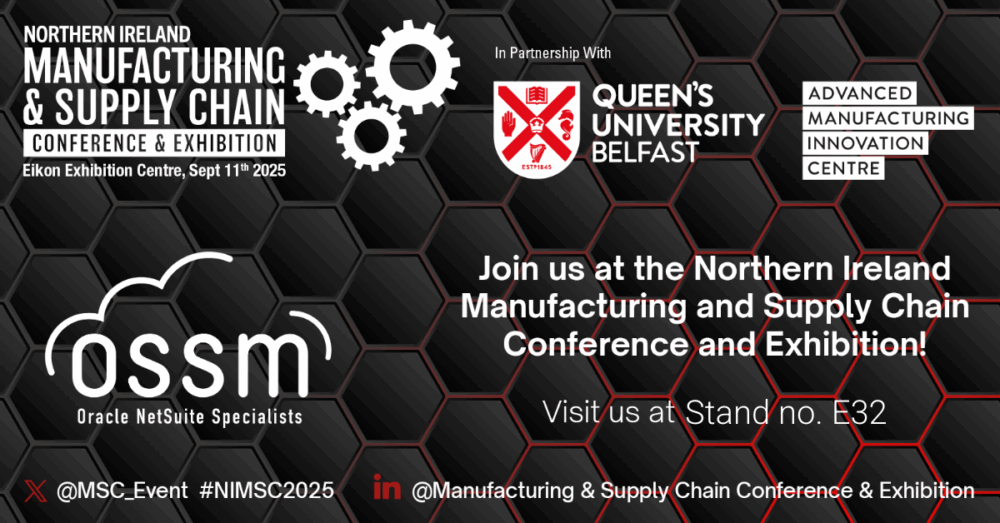
- Manufacturing - Solutions, NetSuite ERP, NetSuite Manufacturing
Many manufacturers only realise how much their old ERP software is slowing them down when growth starts to stall. A system that once worked well can turn into a bottleneck, making it hard to keep production on track, understand what’s happening across the plant, or seize new opportunities. In today’s competitive environment, your software should help you grow, not hold you back.
Across every sector, manufacturing companies are turning to modern manufacturing software systems to stay competitive. Rising customer demand, tighter regulations, and plans to move into new markets all put pressure on processes that may have been reliable years ago but are now out of date. If you keep running into the same problems and patching them with quick fixes, it’s a clear sign your ERP system is no longer keeping pace with your business.
Below, we look at the most common reasons manufacturers struggle to scale with outdated systems and how a modern manufacturing ERP system can help.
Why old manufacturing software systems cause growing pains
Manufacturers face constant pressure to cut costs, work efficiently with fewer resources, and respond quickly to market changes, all while maintaining high quality. The biggest barriers to success often aren’t on the shop floor – they’re buried in ageing ERP software. If these issues sound familiar, it may be time to rethink how your technology supports growth.
A) High maintenance costs
If your team spends more time fixing glitches than improving operations, your ERP has become a liability. Many manufacturers rely on disconnected programs that need frequent troubleshooting and expensive add-ons just to stay functional. Over time, those costs often exceed the price of a modern upgrade, draining funds that could go toward innovation, training, or hiring.
B) Limited functionality
Outdated systems rarely integrate well with newer tools. When staff must re-enter data into separate platforms for finance, production, and inventory, errors and delays multiply. Limited automation adds to the burden. These gaps create silos, hide information, and slow productivity – making everyday work harder than it needs to be and leaving opportunities on the table.
C) Security and compliance risks
Older manufacturing ERP systems typically fall behind on security updates and compliance features. Without up-to-date access controls, audit logs, or real-time traceability, you face higher risks of cyberattacks, failed audits, and supply chain disruptions. For manufacturers in regulated industries, the financial and reputational damage from a security breach can be severe.
D) Lack of real-time visibility
Important decisions are hard to make when you’re looking at last week’s numbers. Many older systems can’t provide live data, so forecasting errors, missed deadlines, and incomplete orders become common. Real-time visibility is now essential for accurate planning and fast responses to market shifts.
E) Difficulty scaling
Expanding into new markets, adding product lines, or opening another facility should be exciting. With outdated ERP software, even small changes like adding users or a new currency often require custom development, delaying projects and raising costs. If growth consistently triggers technical headaches, your system is standing in the way.
Recognising these pain points is the first step toward a better solution. Modern manufacturing software systems address them directly, giving you the tools to compete and grow.
How a modern manufacturing ERP system helps
A unified system such as NetSuite Manufacturing brings together production, inventory, supply chain, and financial data in one place. By replacing a patchwork of outdated tools, it provides the insights and flexibility manufacturers need to run complex operations. Here are some of the key advantages.
A) End-to-end visibility
See what’s happening across your business in real time. A unified cloud platform delivers accurate data for faster, more confident decisions.
B) Automated workflows
Automation reduces manual tasks and errors, so teams can focus on higher-value work and keep pace with demanding production schedules.
C) Advanced inventory management
Demand forecasting, automatic reordering, and live inventory tracking help maintain the right stock levels and reduce waste.
D) Stronger supply chain oversight
Better supply chain visibility keeps materials and finished goods moving smoothly and makes collaboration with suppliers easier.
E) Built-in quality and compliance
Integrated checks throughout the production process support industry regulations and ensure consistent standards, reducing the risk of costly mistakes.
F) Easy cloud scalability
Add new sites, product lines, or users as your business grows without major IT projects or delays.
G) Seamless integration
NetSuite adapts to your specific workflow and connects with other business applications, creating a complete solution rather than another isolated tool.
Ready to see the difference?
If an outdated ERP system is limiting your growth, upgrading to a modern manufacturing ERP system can transform how you operate. NetSuite Manufacturing covers every stage of the process, from order management to shipping, and gives you the flexibility to expand without technology getting in the way.
To explore how NetSuite can fit your business, reach out to us today.
About the Author

Rob Van Der Velden
Rob Van Der Velden is a Consultant at OSSM, specialising in NetSuite implementation project management. He oversees the entire process from pre-sales to training, with expertise in Manufacturing, Project Management, Service Management, CRM, and Distribution & Warehouse Management. Rob excels in workshops, process definition, data migration, customisation, and change management, providing strategic guidance to optimise business processes.





















